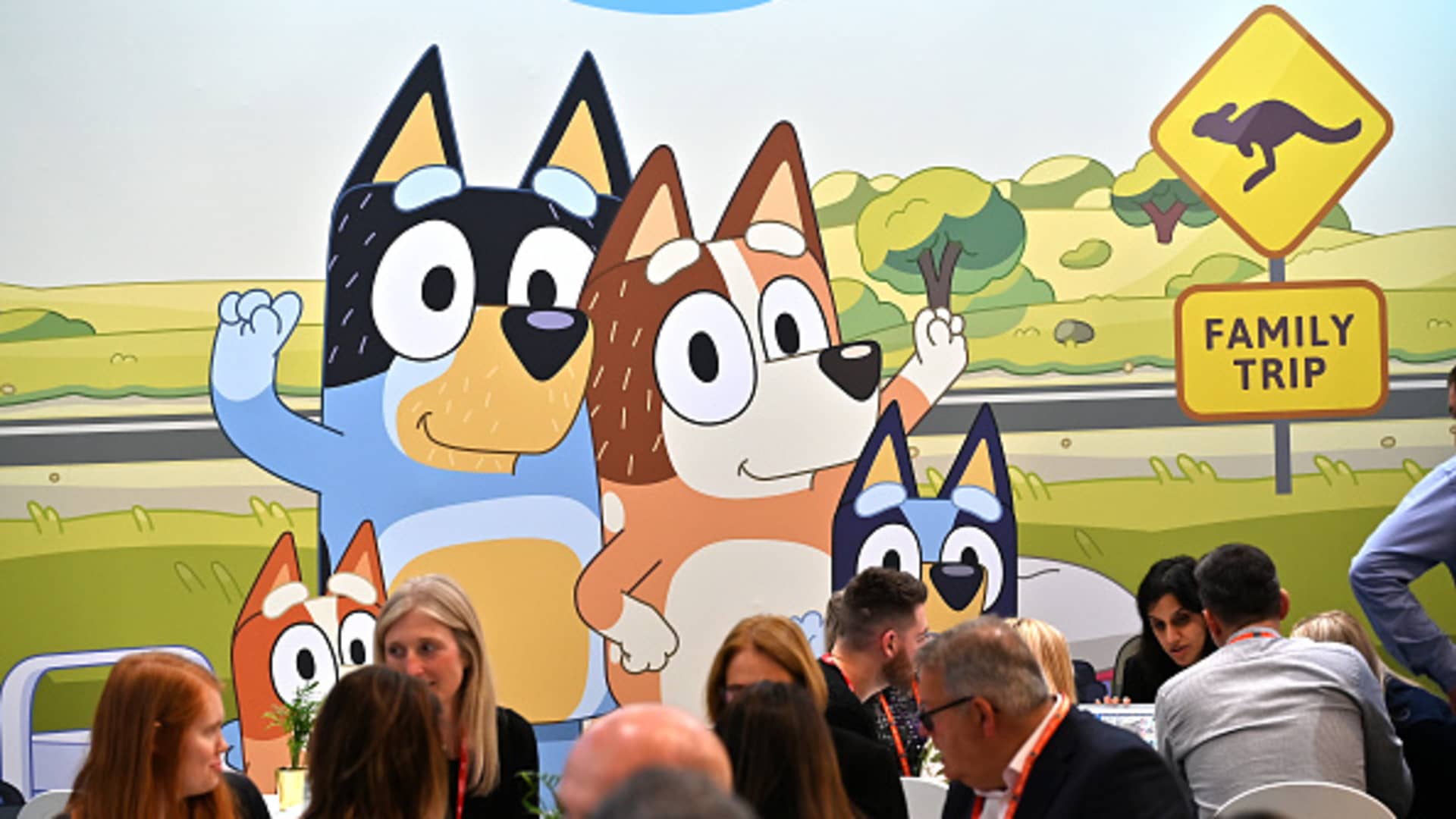Cartoon characters from the children’s show “Bluey” are displayed during the Brand Licensing Europe event at ExCel, in London, Oct. 4, 2023.
John Keeble | Getty Images News | Getty Images
In the battle among streaming services to capture and keep subscribers, kids’ shows like “CoComelon” and “Bluey” are becoming powerful tools to help win the war.
Retaining customers has proven to be one of the biggest hurdles in the build-out of streaming. When Netflix reported subscriber losses in 2022, it sent a ripple effect through the industry and media companies began leaning into advertising and other business models to focus on profitability.
Meanwhile, companies like Warner Bros. Discovery and Disney have been vocal about the need for quality content to drive subscriber growth. Children’s programming offers a unique value proposition for the streaming equation: it’s less expensive and has more longevity than other forms of content.
“Kids’ content drives a huge amount of engagement because kids watch it over and over and over and over. They never tire of it,” said Kevin Mayer, co-CEO of Candle Media, which owns Moonbug, the distributor of hit kids’ shows such as “CoComelon” and “Blippi.”
Mayer said reducing churn — industry jargon for customer losses — is the most substantial factor in improving streaming services’ economics, even more so than gaining new subscribers or generating revenue from those customers.
“If you churn, you lose subscribers, your top line diminishes. You have to spend marketing dollars to replenish, either to re-market to lost subscribers or to find new ones,” said Mayer.
Kids tend to repeat watching shows and movies, and it shows in the data. When there was initially only one season of “CoComelon” on Netflix, kids watched the same episodes multiple times, said Brian Fuhrer, senior vice president of product strategy and thought leadership at Nielsen.
The 154 episodes of animated Australian hit series “Bluey,” which streams on Disney+, had more than 25 billion minutes viewed in the first half of 2025, according to a Nielsen report released in July.
Kids’ films in general have been driving both the box office and have been many of the top streamed titles this year, according to Nielsen. Disney’s “Moana” is the most streamed movie in history and the sequel, “Moana 2,” had 7.2 billion viewing minutes since it was released on Disney+ in March, per Nielsen.
Live sports and hit TV series are often credited with drawing the biggest audiences and driving short-term subscriber additions for streamers, but services that feature strong portfolios of children’s content offer parents a reason to stick with subscriptions longer term, industry analysts and experts told CNBC.
A fourth-quarter video trends report from TiVo found that of nearly 4,500 survey respondents in the U.S. and Canada, those with children use 13.6 services compared with 8.2 for those without. Overall, the report from the fourth quarter of 2024 found that respondents had on average 9.9 services, down from 11.1 in the prior year. TiVo’s report found that people were dropping streaming apps due to lack of usage rather than higher pricing.
Meanwhile, kids being home from school during the summer has helped to spike both streaming and TV usage in June, according to a recent Nielsen report. Total TV usage among 6- to 17-year-olds was up 27% compared with the prior month, and streaming accounted for 66% of their total time spent with TV in June.
The strategy for media companies varies when it comes to using children’s content as a retention tool. Disney, Paramount Global and Netflix are among the streaming services with deep libraries of kids content. WBD, however, has stepped back from the genre, most notably with its decision to relinquish the streaming rights to “Sesame Street.”
The new season of the iconic children’s show will be released on Netflix later this year, with two more seasons to follow. Meanwhile, new “Sesame Street” episodes will also be available on PBS KIDS and its YouTube channel.
Netflix has reported kids’ and family content represents 15% of the company’s total viewing.
Part of the broader media strategy has also come to mean joining forces with the traditional media industry’s biggest competitor — Alphabet‘s YouTube.
YouTube rising
Kid Cowboy episodic still.
Courtesy: Nickelodeon
Even Netflix, the streaming juggernaut that upended the media industry, is faced with the reality that social media platform YouTube is dominating streaming on the TV screen.
YouTube consistently pulls the highest TV viewership among all streaming platforms, according to Nielsen. As of June, YouTube accounted for 12.8% of overall streaming on the TV, surpassing Netflix and Disney+, Nielsen reported. In total, streaming viewership surpassed broadcast and cable TV.
“I would say YouTube is part of everybody’s media strategy,” said Andy Heyward, a longtime media executive in the kids’ television industry and CEO of Kartoon Studios. “More kids are consuming YouTube than anything else. But there’s so much stuff on there that you have be very, very unique to rise above.”
YouTube strategy used to be an afterthought for many media companies, but that’s since changed, according to Alexia Raven, who spearheaded generational research as a former executive at Warner Bros. Discovery and has since co-founded the research and strategy firm Maverix Insights.
“If you’re not on YouTube, it’s like you don’t exist for kids,” Raven said. “That’s where the eyeballs are.”
In response, traditional media companies are increasingly working “as close partners” with YouTube — creating and curating YouTube channels with clips from specific content and TV networks, and even creating shows just for the platform, said Katie Kurtz, the global head of youth and learning at YouTube.
“I think we certainly know that some partners think of YouTube as the engine of discoverability. They want to make sure they’re meeting users where they are, and so they are on YouTube as a way of connecting with audiences,” said Kurtz.
The content Disney produces for YouTube serves to complement its long-form series on Disney+ and fuel deeper engagement with its characters and stories, a Disney spokesperson told CNBC.
Paramount credits its library of kids programming as helping to establish Paramount+ as one of the fastest-growing streaming services, according to a spokesperson — much of which comes from cable TV network Nickelodeon. Franchises like “Paw Patrol,” “SpongeBob SquarePants” and “Dora the Explorer” have been particularly successful.
Still even with that depth in kids’ programming, Paramount earlier this year released the original animated series, “Kid Cowboy,” exclusively on YouTube.
“We also know that a lot of our partners are not really just building large YouTube channels. They are also thinking about building a really great next generation of characters, and some of that involves being YouTube first,” said Kurtz, calling out “Kid Cowboy” as an example.
CoComelon crossover
CoComelon.
Courtesy: Netflix
Meanwhile, traditional media companies are also looking to YouTube for new forms of content to add to their platform. In recent years, content makers who started out on YouTube have signed licensing deals with top streaming services.
“We want to be in business with the best creatives on the planet, regardless where they come from,” said Netflix co-CEO Ted Sarandos during Thursday’s earnings call with investors.
“CoComelon” in particular stands out.
The animated series originated on YouTube and still reaches much of its viewers there, but when Netflix acquired a subset of its content in 2020, it was a boost for Netflix’s viewership.
It has appeared in Nielsen’s top 10 list of acquired titles a total of 179 times, with 155 consecutive appearances on the rankings. However, it was last featured on the list in September 2024.
Despite its slowdown in viewership, “CoComelon” managed to nab a new subscription streaming home with Disney+ this year, according to people familiar with the matter who declined to speak publicly on the private negotiations. Disney outbid Netflix for the rights to the program beginning in 2027 and Netflix refrained from submitting a higher bid, the people said. Netflix declined to renew its “CoComelon” license due to a decline in viewership, one of the people said.
Netflix saw the hours spent viewing “CoComelon” decline nearly 60% from early 2023 — when it started releasing engagement data — to late 2024.
A Disney spokesperson said that “CoComelon” continues to be a top destination for preschool-aged children, adding the show fits seamlessly into its preschool ecosystem and supports engagement and retention with its young audiences, which is a key driver of platform health.
Despite letting go of “CoComelon,” Netflix is still investing in kids content. Earlier this year, Netflix added “Ms. Rachel” content, which is programming from a YouTube creator of toddler and preschooler content of the same name whose channel has nearly 16 million subscribers.
The series has been in Netflix’s top 10 most watched “shows” globally for 17 weeks, according to the company.
“There are some creators on YouTube like Ms. Rachel that are a great fit,” Sarandos said on Thursday’s call. “If you just saw on the engagement report, she’s had 53 million views in the first half of 2025 on Netflix. So she clearly works on Netflix.”





